Gujarati Language

 Introduction
IntroductionThe language of Gujarati also known as Gojarati or Gujerati is the official language of the State of Gujarat. The language is named after the Gurjar/Gujar community people who are said to have settled in the region sometime in the middle of the 5th century C.E.
The language is actually a part of the Indo-Aryan family which is a branch of the Indo-European languages. It also comes under one of the 22 official languages recognized by the Government of India. Apart from Gujarat this language is also spoken in adjacent union territories of Daman and Diu and Dadra and Nagar Haveli.Gujarati language stands at the 26th position among the most spoken native language in the world and nearly 46.1 million people speak Gujarati through out the world.
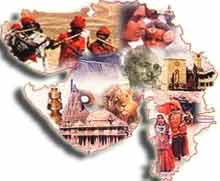 Most of the words in Gujarati are taken from Sanskrit with slight modifications where the top line of the letters are omitted.The vocabulary of the Gujarati language is small and is dependent on Sanskrit to express complex metaphysical and scientific disquisitions.
Most of the words in Gujarati are taken from Sanskrit with slight modifications where the top line of the letters are omitted.The vocabulary of the Gujarati language is small and is dependent on Sanskrit to express complex metaphysical and scientific disquisitions. The Gujarati language is also noted for its simplicity where it doesn't have much of conjugations ands nouns.Gujarati was the mother tongue of Mohandas K. Gandhi, the "father of India", and Sardar Vallabhbhai Patel, the "Iron man of India".
 History
HistoryThe history of the language can be traced back to 12th century CE and can be divided into three periods namely the old, middle and the modern period.
The Old Period
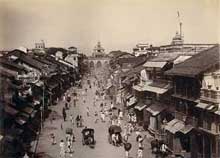 The Old Period belongs to the 10th-14th century and it was during this time the Parsis learned Sanskrit. After this they translated most of their religious text belonging to the Middle Persian versions into Sanskrit. But soon after when the Muslim rulers took over Gujarat, the people studied Arabic and Persian language which led to the decline of Sanskrit studies. As Sanskrit was slowly loosing its use, the texts of Avestan and Pahlavi were translated into Gujarati.
The Old Period belongs to the 10th-14th century and it was during this time the Parsis learned Sanskrit. After this they translated most of their religious text belonging to the Middle Persian versions into Sanskrit. But soon after when the Muslim rulers took over Gujarat, the people studied Arabic and Persian language which led to the decline of Sanskrit studies. As Sanskrit was slowly loosing its use, the texts of Avestan and Pahlavi were translated into Gujarati. The Middle Period
The Middle Period which takes over the period between 15th to 17th centuries witnessed Gujarati being strongly influenced by Persian and Urdu which also became the court language at that time. But however in the nearby villages of Gujarat like Surat, the Parsis used the Gujarati language to speak. They translated religious texts into Gujarati, which had traces of Sanskrit, Persian and local dialects.
Modern Period
The period of the 17th century takes up the era of the Modern Period during which there started a move in a quiet, stealthy way of the British Romanticism and styles and thus the language of Gujarati was slowly getting Westernized.It was during this time the British was slowly trying to establish themselves in India. The modern Gujarati having consonant final words was developed in this period. The people were very much influenced by the structural peculiarities of the English language and they started using it in their own language. Some of the renowned works during the end of the 19th century in Gujarati languages are
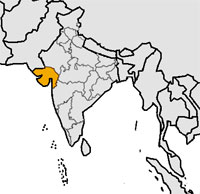
- 1840 - Personal diary composition: Nityanondh, Durgaram Mahetaji.
- 1851 - First essay: Narmada Shankar Lalshankar Dave.
- 1866 - First novel: Nandashankar Mehta.
- 1866 - First autobiography: Narmada Shankar Lalshankar Dave.
 Language
LanguageA manuscript belonging to 1592 believed to be the oldest known document in the Gujarati script has also been found. In 1797 it got its first appearance in print and it was used mainly for writing letters and keeping accounts till the 19th century whereas for literature and academic writings the Devangiri script was used. But now the Gujarati script is used for writing Gujarati as well as Kutchi is Abugida which is derived from the Nagari Writing system. Devnagari script slightly varies from that of the Gujarati script by the absence of horizontal line running above the letters.
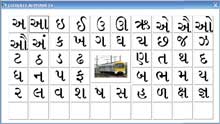 This can be written in Arabic as well Persian Scripts which is still followed by natives in Kutch district of Gujarat. But the dialects keep slightly varying from in different areas like :
This can be written in Arabic as well Persian Scripts which is still followed by natives in Kutch district of Gujarat. But the dialects keep slightly varying from in different areas like :- Standard Gujarati – Saurashtra Standard, Nagari, Bombay Gujarati, Patnuli
- Gamadia – Gramya, Surati, Anawla, Brathela, Eastern Broach Gujarati, Charotari, Patidari, Vadodari, Ahmedabad Gamadia, Patani Parsi
- Kathiyawadi –Jhalawadi, Sorathi, Holadi, Gohilwadi, Bhavnagari,Kharwa,Kakari Tarimuki – Ghisadi
 Literature
Literature The literature of Gujarati can again be divided into three periods where the earliest writings was mostly by the Jaina authors which took three forms namely the Rasas, Phagus and Vilasas.The rasas were long poems which were heroic, romantic or narrative in nature. Some of the poems which comes under this category are:
- Salibhadra Suri's Bharatesvara Bahubalirasa (1185 AD)
- Vijayasena's Revanagiri-rasa (1235 AD)
- Ambadeva's Samararasa (1315 AD)
- Vinayaprabha's Gautama Svamirasa (1356 AD)
- Sridhara's Ranamalla Chanda (1398 AD)
- Merutunga's Prabodhachintamani Padmanabha's Kanhadade Prabandha (1456 AD)
- Bhima's Sadayavatsa Katha (1410 AD).
- Rajasekhara's Neminatha-phagu (1344 AD)
- Gunavanta's Vasantha-vilasa (1350 AD)
- Vinayachandra's Neminatha Catuspadika (1140 AD)
- Tarunaprabha's Balavabodha (1355 AD)
- Manikyasundara's Prithvichandra Charita (1422 AD)
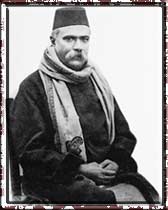 The 17th and the 18th centuries were taken over by three great poets namely Aksayadasa or Akho (1591-1656), Premananda Bhatta (1636-1734) and Syamaladasa Bhatta or Samala (1699-1769).Akho's striking works on vedanta includes Akho Gita, Cittavicara Samvada and Anubhava Bindu.Premananda Bhatta gave a new facelift for Gujarati language and literature and some his important works include Okha Harana, Nalakhyana, Abhimanyu Akhyana, Dasama Skandha, Sudama Charitra and Sudhanva Khyana.One of the most productive poet of this period was Samala who is the author of works like Padmavati, Batrisa Putali, Nanda Batrisi, Simhasana Batrisi and Madana Mohana. Many devotional poetry also came up during this period and few of the important saint poets are Parmanand, Brahmanand, Vallabha, Haridas, Dhira Bhagat and Divali Bali.
The 17th and the 18th centuries were taken over by three great poets namely Aksayadasa or Akho (1591-1656), Premananda Bhatta (1636-1734) and Syamaladasa Bhatta or Samala (1699-1769).Akho's striking works on vedanta includes Akho Gita, Cittavicara Samvada and Anubhava Bindu.Premananda Bhatta gave a new facelift for Gujarati language and literature and some his important works include Okha Harana, Nalakhyana, Abhimanyu Akhyana, Dasama Skandha, Sudama Charitra and Sudhanva Khyana.One of the most productive poet of this period was Samala who is the author of works like Padmavati, Batrisa Putali, Nanda Batrisi, Simhasana Batrisi and Madana Mohana. Many devotional poetry also came up during this period and few of the important saint poets are Parmanand, Brahmanand, Vallabha, Haridas, Dhira Bhagat and Divali Bali.
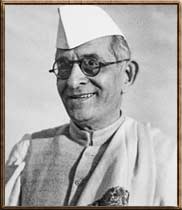 Slowly with the start of the 19th century there were lot of influence from the western writtings leading to modern Gujarati literature and the pioneers were Dalpat Ram (1820-1898) and Narmada Shankar. Narmada Shankar's Rukmini Harana, Vana Varnana and Virasimha are excellent collection of poems. The other great works in Gujarati poetry include Bholanath Sarabhai's Ishvara Prarthanamala (1872), Narsimharao Divatia's Smarana Samhita, Kusumamala, Hridayavina, Nupura Jhankara and Buddha Charita; Manishankar Ratanji Bhatt's Devayani, Atijnana, Vasanta Vijaya and Chakravaka Mithuna and Balwantrai Thakore's Bhanakara.
Slowly with the start of the 19th century there were lot of influence from the western writtings leading to modern Gujarati literature and the pioneers were Dalpat Ram (1820-1898) and Narmada Shankar. Narmada Shankar's Rukmini Harana, Vana Varnana and Virasimha are excellent collection of poems. The other great works in Gujarati poetry include Bholanath Sarabhai's Ishvara Prarthanamala (1872), Narsimharao Divatia's Smarana Samhita, Kusumamala, Hridayavina, Nupura Jhankara and Buddha Charita; Manishankar Ratanji Bhatt's Devayani, Atijnana, Vasanta Vijaya and Chakravaka Mithuna and Balwantrai Thakore's Bhanakara.
Nanalal was another important poet of this period who excelled in his apadya gadya or rhyming prose. He has to his credit two poetic collections - Vasantotsava (1898) and Chitradarsana (1921), an epic called Kuruksetra and several plays like Idukumara, Jayajyanta, Viosva Gita, Sanghamitra and Jagat Prerana.The modern Gujarati prose was pioneered by Narmada Shankar (Ragrang), Mansukhram Tripathi, Naval Ram, K.M.Munshi and Mahatma Gandhi.


